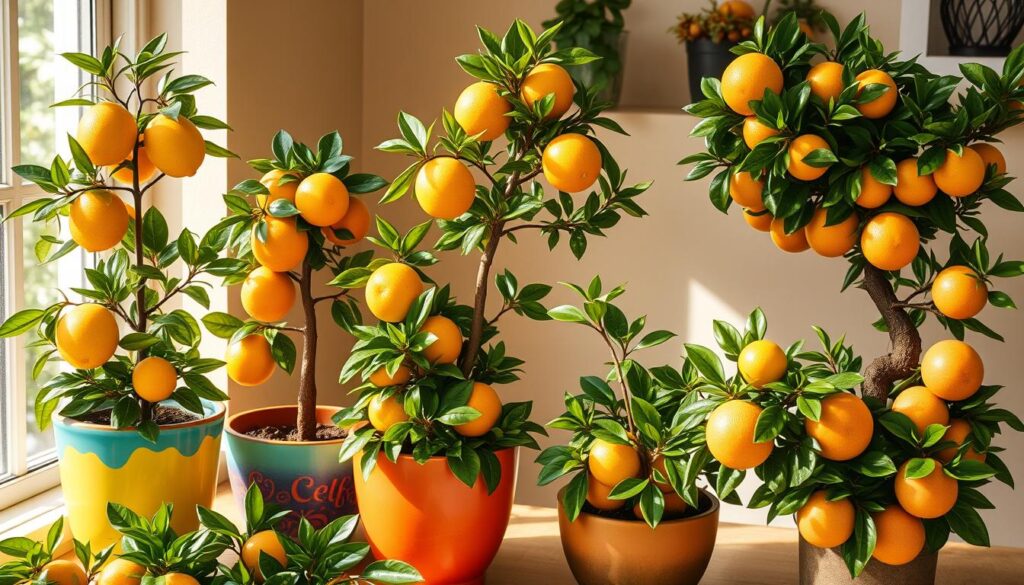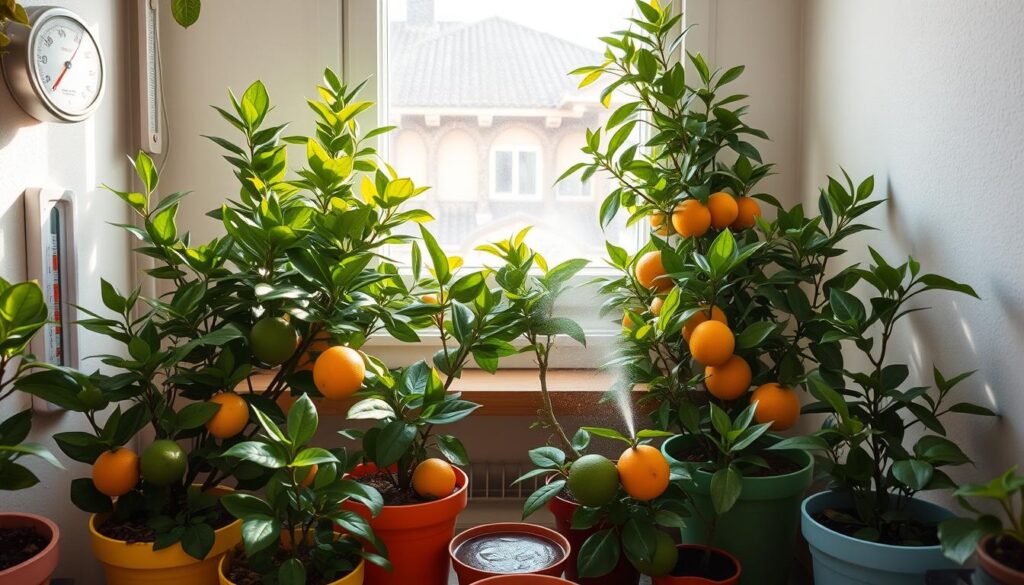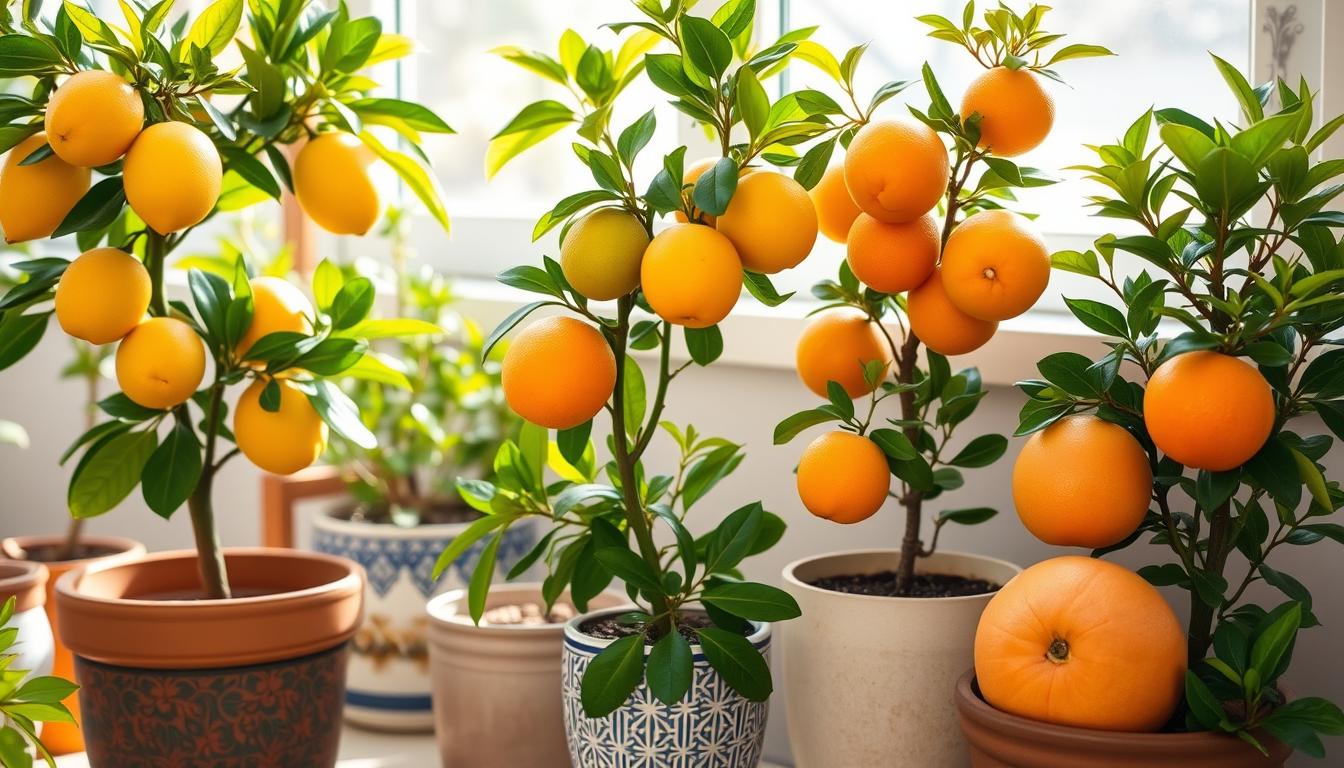Indoor gardening is becoming more popular, and growing your own fruits and veggies at home is appealing. Growing citrus indoors is especially attractive. It brings fresh flavors, improves your home’s look, and boosts health. In this article, I’ll show you the top 5 citrus fruits to grow indoors. I’ll share tips on how to care for them and enjoy fresh produce right away.
Meyer lemons and calamondin are just a few varieties that can grow well indoors. With the right care, anyone can grow citrus indoors. As we explore each fruit and the basics of indoor gardening, I hope to encourage you to start your own citrus growing journey. For more tips, check out Urban Leaf and Garden Beginner for great advice and community support.
Key Takeaways
- Growing citrus indoors can enhance home décor while providing fresh produce.
- Meyer lemons, calamondin, and other dwarf varieties are suitable for indoor gardening.
- Proper light, temperature, and humidity are vital for citrus success indoors.
- Regular care, including watering and pest management, ensures healthy growth.
- Indoor citrus gardening is rewarding and accessible for both beginners and seasoned gardeners.
Introduction to Indoor Citrus Gardening
Growing citrus indoors is a favorite hobby for many gardeners. These plants take up little space but add color and scent to any room. Enjoying the fruits of your labor at home is incredibly rewarding.
Citrus trees do well indoors if given the right conditions. They need 6-8 hours of sunlight a day to grow and produce fruit. A well-kept indoor garden can turn your home into a citrus paradise.
For a thriving indoor citrus garden, use well-draining soil like Espoma Organic Cactus Mix. It’s made for citrus plants. Keeping the right light and humidity levels is key. Humidity between 40-60% helps plants grow well, especially in dry winter months.
Prune your citrus trees in early spring to encourage growth and fruit. Fertilize with Espoma Citrus-Tone during the growing season. Water consistently, letting the soil dry a bit between waterings to avoid root rot.
Growing citrus indoors is a rewarding hobby. It connects you to nature and lets you enjoy fresh fruits at home. By choosing the right varieties and keeping the right conditions, you can have citrus all year round.
Benefits of Growing Citrus Indoors
Growing citrus indoors can change my living space for the better. It adds beauty with its bright leaves and sweet smells. Plus, it brings fresh food and cleaner air into my home.
Enhancing Your Home Environment
Citrus plants make any room feel happier and fresher. Their green leaves and colorful fruits are like natural decorations. They also help clean the air by removing toxins.
With the right care, my home can become a lively oasis. It will be filled with the sweet scent of citrus flowers.
Fresh Produce at Your Fingertips
Having citrus fruits from my own plants is incredibly rewarding. I can grow Meyer lemons or limes indoors. These fruits taste better and are free from harmful chemicals.
The joy of picking and using these fruits in recipes is unmatched. I also love hand-pollinating my trees to get more fruit. It’s a fun and delicious process.
Exploring indoor gardening brings many benefits. It improves my gardening skills and fills my home with beauty and flavor. Caring for my citrus plants connects me to nature, even indoors.
For more on the benefits of indoor gardening, check out this link.
Top 5 Citrus Fruits You Can Grow Indoors
Growing citrus fruits indoors lets me enjoy tasty flavors at home. The top 5 citrus fruits for indoor growing are rewarding. Each one needs the right care and adds something special to my garden.
Meyer Lemon
The Meyer lemon is great for indoor growing. It has a sweet taste and blooms often. With enough sunlight and care, it gives lots of fruit.
Bearss Lime
Bearss lime is known for its juicy, tangy taste. It’s perfect for cooking. With proper care, it grows well indoors, needing 10 to 12 hours of sunlight.
Kaffir Lime
The Kaffir lime tree is loved for its aromatic leaves. These leaves are key in Asian cooking. It needs careful care, including enough water and light, to thrive.
Calamondin
Calamondin is a small, tart fruit great for indoor gardens. Its trees are small and fit well in tight spaces. The fruit is tasty in drinks, marinades, and desserts. With the right light and care, these trees do well indoors.
Nagami Kumquat
Nagami kumquat trees have sweet fruits with a tangy inside. You can eat them whole. They need plenty of light and regular watering to grow well.

| Citrus Fruit | Flavor Profile | Light Requirements | Noteworthy Characteristics |
|---|---|---|---|
| Meyer Lemon | Sweet | 8-12 hours | Fragrant blooms, yellow fruit |
| Bearss Lime | Tangy | 10-12 hours | Juicy, strong flavor |
| Kaffir Lime | Aromatic | 8-10 hours | Fragrant leaves for cooking |
| Calamondin | Tart | 8-10 hours | Ideal for beverages and marinades |
| Nagami Kumquat | Sweet-sour | 8-10 hours | Eat fruit whole, rind and all |
Choosing any of these top 5 citrus fruits for indoor growing will make my garden better. It lets me enjoy fresh flavors all year.
Choosing the Right Indoor Citrus Varieties
Choosing the right indoor citrus varieties is key for a successful garden. Dwarf varieties are perfect for small spaces. They need less sunlight and produce delicious fruits. Meyer lemons, Bearss limes, and Calamondin are top picks for indoor gardens.
When starting a young tree, remove flower buds in the first years. This helps the tree grow strong roots and eventually produce fruit. Plants like Thai lime and Fukushu kumquat are great for indoor growth.
It’s crucial to pick the right indoor citrus varieties. Indoor trees need 8-12 hours of sunlight daily. Use a citrus/cactus blend with compost for the best soil.
Good lighting, like T5 fluorescent bulbs, is also important. Knowing the care needs of different trees helps you choose the best. This way, you’ll enjoy a bountiful indoor garden.
| Citrus Variety | Fruit Characteristics | Sunlight Requirements | Ideal Temperature |
|---|---|---|---|
| Meyer Lemon | Sweet, juicy lemons | 8-12 hours | 60°F – 85°F |
| Bearss Lime | Thin-skinned, juicy limes | 8-12 hours | 60°F – 85°F |
| Calamondin | Super-sour small fruits | 8-12 hours | 55°F – 85°F |
| Kaffir Lime | Fragrant leaves and fruit | 8-12 hours | 60°F – 85°F |
| Nagami Kumquat | Edible, sweet-sour fruit | 8-12 hours | 55°F – 85°F |
Keep the humidity right and water regularly to help your trees grow. For more on how we handle your personal info, check our privacy policy.
Essential Light and Location Requirements
Knowing the right light and spot for growing citrus indoors is key. Citrus trees need bright, direct sunlight for at least 6 hours a day. For the best fruit, 8-12 hours of sunlight is best.
Since indoor spots can be limited, I place my citrus near south-facing windows. This way, they get the most sunlight all day.
Finding the Perfect Spot
Finding the right spot for my citrus trees involves several factors. I consider:
- Sunlight exposure: A south-facing window is usually best, as it receives abundant daylight.
- Room temperature: Maintaining a range of 65 °F to 85 °F supports healthy indoor plant growth.
- Humidity levels: Citrus trees prefer a humidity range of 30% to 60%, so I often use a humidifier if my home is particularly dry.
Supplementing Natural Light
Natural light can sometimes fall short, especially during winter months or in rooms with limited sunlight. Artificial lighting helps fill this gap. LED or fluorescent grow lights are great for this.
I place these lights 12-18 inches above the plants. This gives them the right light spectrum for growth. This way, I can grow vibrant, fruitful citrus even in tough spots.
Optimal Temperature and Humidity Levels
Caring for indoor citrus plants means knowing their temperature needs. They do best in a range of 55°F to 85°F. The sweet spot is 65°F for growth.
Extreme temperatures can harm them. If it’s too cold, they might stop growing and not produce fruit.
Humidity is also key for citrus plants. They love a humid environment. To keep the air right, use a humidity tray near your plants.
Place a shallow dish with water and pebbles under the pots. The water should be just below the pebbles. This lets moisture evaporate around the plants without soaking the soil.

In short, the right temperature and humidity are crucial for indoor citrus care. Keep a close eye on your indoor climate. This ensures your citrus plants stay healthy and fruitful.
Indoor Citrus Care: Watering and Feeding
Proper care is key for a healthy indoor citrus garden. Knowing how to water and feed your trees is crucial. Citrus plants need careful watering, as too much water can kill them. Watering once a week is usually enough, letting the soil dry out in between.
Check the soil moisture often. Signs of root rot, like dropping leaves and dying twigs, mean you need to adjust your watering.
Understanding Watering Needs
Keeping the right moisture level is important for watering indoor plants. Citrus trees like moist soil but the top inch should dry out before watering again. This helps roots grow strong and prevents diseases.
Adjust your watering based on the environment. Indoor citrus trees do best in temperatures between 55°F and 85°F (13°C-29°C).
Fertilization Tips for Healthy Growth
Feeding your indoor citrus is also crucial. Use a balanced, slow-release fertilizer, like organic granular citrus fertilizer, during the growing season. Feed them monthly from spring to early fall for strong growth and more fruit.
Timing is everything when fertilizing. It should match the plants’ natural growth cycles. For more tips on caring for your indoor citrus, check out this guide.
Soil and Potting Considerations
Starting a citrus garden indoors requires the right soil and potting. The soil’s quality is key for your tree’s health and growth. Choosing the right mix and pot size is crucial for success.
Selecting the Right Soil Mix
I suggest using a citrus or cactus mix with compost. This mix helps with air and water. Citrus trees need soil with a pH between 6.0 and 7.0 for fruit growth.
Pot Size and Drainage Solutions
Choosing the right pot size is important. A small pot can limit growth, while a large one can cause too much water. Pots with holes help prevent root rot.
Adding perlite or gravel to the soil improves drainage. Deep waterings keep the soil moist but not soggy. This keeps your trees healthy and productive.
Pest Management for Indoor Citrus Trees
Effective pest management is key for indoor gardening. Common pests like spider mites and scale can harm citrus trees. Regular checks are vital to catch problems early.
I look for signs of pests, such as discolored leaves or sticky residue. This way, I can tackle issues before they get worse.
For pest control, I use natural methods that are safe and work well. A mix of soap and water is effective against pests. It also refreshes the leaves, keeping my trees healthy.
Keeping the growing area clean is also important. I clean around the plants and remove dead leaves. This helps prevent pests from breeding. With these steps, my indoor citrus gardening is successful and pest-free.



Leave a Reply